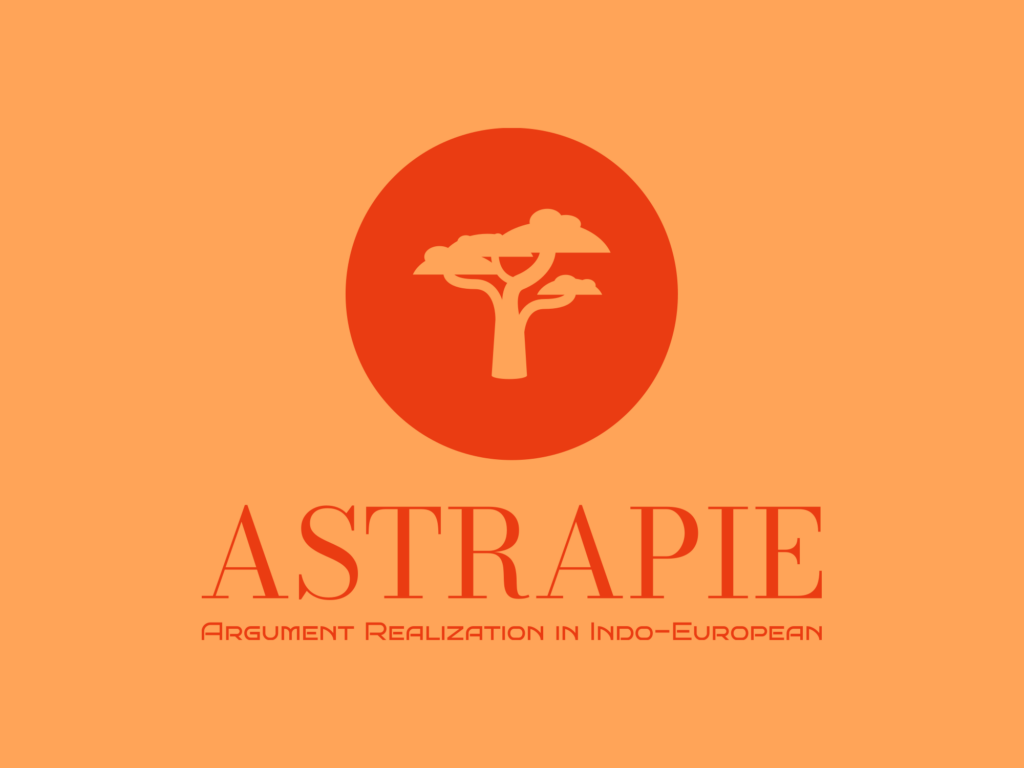
This is the homepage of the project ‘Alignment, Subjecthood and Transitivity Prominence in Indo-European’ (ASTRAPIE) funded by the NCN under the POLONEZ BIS programme
Polonez bis
Project title: Alignment, Subjecthood, and Transitivity Prominence in Indo-European’
Acronym: ASTRAPIE
Core project members: Dr. habil Eystein Dahl - Principal Investigator Dr. habil Krzysztof Stroński - Co-Investigator MA Tania Ahmad - PhD student Mgr. Katarzyna Budasz-Organista – Administrative and financial assistant
External project collaborators:
Prof. Dr. Paola Cotticelli-Kurras, Università di Verona, Italy
Dr. Jelena Živojinović, Università di Udine/Università di Verona, Italy
Dr. Sepideh Koohkan, Tarbiat Modares University, Iran
MA Diego Luinetti, Università Marconi, Italy
MA Carlo Maria Pertica, Università per Stranieri di Siena, Italy
MA Iulia Petrariu, Georg-August-Universität, Göttingen, Germany, and University of Cluj-Napoca, Romania
MA Henrik Hornecker, Humboldt-Universität zu Berlin, Germany
MA Ottavia Cepraga, Università per Stranieri di Siena, Italy
This project investigates the historical interrelationship between alignment, subjecthood, and transitivity prominence across the Indo-European linguistic family. It focuses on how the formal expression and grammatical behaviour of subjects, objects, and verbal predicates differs across languages. This can be illustrated by the English sentences I kill him, I run vs. he kills me, he runs. These sentences illustrate that the pronoun forms I and he are used to express the logical subject or agent (A) of kill and the subject (S) of run, while other forms, me and him, are needed to express the logical object or patient (P) of kill. Moreover, the verbs kill and run have different forms when the logical subject is in the first or third person, as illustrated by the forms kill/kills and run/runs. In English, then, (some) pronouns have the same expression in A and S function, and a different form in P function. This illustrates accusative alignment, found in many languages. Nouns show a different pattern in English. This is shown by sentences like the man kills the dog, the dog kills the man, the man runs. Here, identical forms are used in A, S and P function but. This grammatical pattern illustrates neutral alignment, which is also very common. A third alignment pattern is illustrated by the examples from the Australian language Dyirbal given below.
yabu [mother:ABS] ŋumaŋgu [father:ERG] buran [see:NONFUT] ‘‘Father saw mother’ (after Dixon 1994)’
ŋuma [father:ABS] yabuŋgu [mother:ERG] buran [see:NONFUT] ‘Mother saw father’ (after Dixon 1994)
yabu/ŋuma [mother:ABS/father:ABS] ban [return:NONFUT] ‘Mother/father returned’ (adapted from Dixon 1994)
Here, the P yabu ‘mother’/ŋuma ‘father’ of the verb buran ‘see’ is identical to the S of the verb banaganṷu ‘return’. The A of the verb buran ‘see’ has a different expression, ŋumaŋgu/yabuŋgu. This pattern is called ergative alignment. It is less common than accusative and neutral alignment. Other patterns exist but this suffices to illustrate what alignment is.
Subjecthood is a more abstract notion, involving features on different levels of grammar, in particular syntax. For example, in English only the subject can be antecedent to reflexives, as illustrated by he told them about himself/*themselves. Moreover, only subjects (A/S) can be omitted in control infinitives, as illustrated by he promised to kill her or he promised to go, where the implicit subject of to help and to go is the same as the subject of promised. While these constructions are clear-cut subject features in English, they do not necessarily count as subject features in all languages. Interestingly, even genetically related languages show variation in this respect, as, for instance, control infinitives are restricted to subjects in Latin but not in Vedic Sanskrit.
All languages show variation in subject and object marking, as illustrated by English he loves me and he looks at me. The verb love shows the same formal marking of subject and object as the verb kill, while the verb look obligatorily selects a prepositional phrase to be grammatical, cf. *he looks her. Some two-argument verbs, that is, verbs that require a subject and an object to be grammatical, such as kill, break, build, describe a situation where the first argument causes a change of state in the second argument. Verbs of this type are regarded as prototypically transitive and are taken to play a central role in the organisation of the verbal lexicon. Many follow the same coding pattern as prototypically transitive verbs, which can be defined as canonical. However, it is often the case that a verb that follows the canonical coding pattern in one language, such as help in English (cf. he helps him vs. he kills me), shows a non-canonical coding pattern in another, as illustrated by German helfen ‘help’ (er hilft mir vs, er tötet mich). Thus, languages differ regarding which and how many verbs that show the canonical coding pattern. Transitivity prominence is the relative portion of verbs showing canonical, transitive coding and provides a measure for comparing the uniformity of the verbal lexicon in different languages.
Alignment, subjecthood and transitivity prominence are seemingly closely interrelated. The present project aims to explore their relationship based on data from Old Indo-European languages. We will work with a sample of representative languages: Hittite, Sanskrit, Ancient Greek, Latin, Classical Armenian, Tocharian B, Gothic, Old Irish, Old Lithuanian, Church Slavonic and Albanian. The goals of the project are:
- To break down the alignment patterns in each of the languages in the sample into fine-grained formal and functional variables that enable precise analyses that can be compared across languages
- To identify the full set of subject features in each of the languages under scrutiny
- To establish the transitivity prominence in the lexicon of each language
- To explore the interaction between alignment, subjecthood, and transitivity prominence in each language
- To develop a comparative-historical analysis of the diachronic relationship between these three domains
We will address the following research questions: a) How are alignment, subjecthood, and transitivity synchronically and/or diachronically interrelated? What principle or principles determine their correlation, if any? b) What is the range of divergence in each of the three domains across the genetically related languages in our sample? There are also some broader questions relating to genealogy and diachronic typology. For example, what, if any, common patterns of change can be discerned across the languages in the sample? To what extent does this reflect shared inheritance? Are the attested changes determined by language-specific features or do they reflect more general processes of change?
The results will deepen our understanding of variation and change across languages. They will also contribute to clarifying how closely related grammatical domains interact in shaping grammatical structure.
Project location: The ASTRAPIE project is hosted by the Faculty of Modern Languages and Literatures at Adam Mickiewicz University in Poznań (https://wn.amu.edu.pl/sprawy-naukowe/projekty). Professor Stroński, the current Dean of the Faculty, is Co-Investigator of and formally mentors the project. Dr. Eystein Dahl is affiliated with the Institute of Oriental Studies at Adam Mickiewicz University (http://orient.amu.edu.pl/).
This research is part of the project No. 2022/47/P/HS2/02564 co-funded by the National
Science Centre and the European Union’s Horizon 2020 research and innovation
programme under the Marie Skłodowska-Curie grant agreement No 945339.



